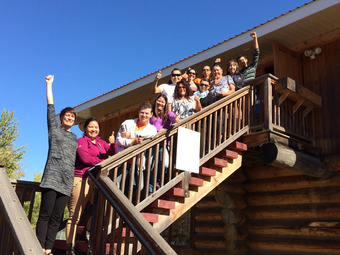 The First Nations Language Centre at SFU is coordinating the activities of grassroots community partners across BC and academic linguists from SFU, UBC, UNBC, and many other universities in a new project to document, analyse, and revitalize Aboriginal languages. SFU's program is one core support pillar in making the Syilx Language House a reality. We are proud to see our project written up on their website and to be supported by them. You can read the write up by clicking this link.  October 7, 2015 Eighteen students are rising to the challenge to revitalize their critically endangered language. “kwu sqilxʷ, kwu sʔaláʔ, uł kwu sqwaʔqwaʔál: we are sqilxw (Okanagan), we are here, and we are beginning to speak,” says Sʔímlaʔxw (pronounced Seemlaw) Michele Johnson, lead teacher of the group. She adds, “our language is deeply connected to who we are and to the health and well-being of our communities.” Johnson launched a bold collaboration between Osoyoos Indian Band, Penticton Indian Band, and Westbank First Nation, leading with the words: kn kł sqiʔs – I have a dream. Nsyilxcn (Okanagan language), like most Indigenous languages, is critically endangered. There are fewer than one-hundred fluent Elders remaining, and no new speakers have been created in Canada in over sixty years. The Syilx Language House Association was formed to reverse this trend, a vision Johnson has been working towards for six years. She began by completing her PhD in language revitalization at UBC-Okanagan, “I decided to take on the challenge of creating ten new speakers. I wanted to learn how to do that.” She found her answers with the Paul Creek curriculum, cleverly designed so beginners can learn while teaching. “We are so lucky to have this; it gives us the opportunity to raise each other up,” she says of the six cutting-edge textbooks co-written in Keremeos by Chris Parkin, LaRae Wiley and Sarah Peterson. When asked if young people really want to learn, Johnson answers, “there are several young people in each community that are passionate about learning language—that are taking it on as a role and responsibility to their communities.” Although most Indigenous languages are critically endangered, people want them back. A quick Google search shows that First Nations language programs across Canada are springing up to reverse language decline. In fact, Syilx community members and Elders stress that language and culture are of paramount importance. “In our Comprehensive Community Plan, language and healing were our top priorities,” says Chief Jonathan Kruger of the Penticton Indian Band. He added, “Chief Clarence Louie challenged all the Chiefs to do more language. Our Council heard Paul Creek was the best model and language houses were having success. We wanted to bring it here. The Chiefs were all talking about it and I said, ‘I’m going to invest in it and build a language house.’” Penticton Indian Band was the first to invest core funding and to provide a classroom location, followed by support from Osoyoos Indian Band and Westbank First Nation. Each Band sponsored employees to attend two days a week for four years and provided core funding. The program has thirteen beginners, five co-teachers (also students), and four Elders from across the Syilx territory, Penticton, Osoyoos, Keremeos, Westbank, Vernon, and the Okanagan Nation Alliance. After four years, Johnson promises intermediate speakers, “It really is the first time we have attempted to create new Nsyilxcn speakers—research shows that it takes 2,000 hours of study to create a high-intermediate speaker.” Over the course of the program, Johnson and her staff will also record Elders, publish language books and CDs, and host open-house community events. Johnson would like to express gratitude to supporters and partners, including Penticton Indian Band, Osoyoos Indian Band, Okanagan Nation Alliance, Okanagan Indian Band, First Peoples Cultural Council, Land Strategies, Columbia Power, and Simon Fraser University. The Association is fundraising for next year’s operating budget and welcomes community visits, donations, and volunteers from community. Further details and contact information are available on the Association’s website: www.thelanguagehouse.ca. |
Archives
January 2024
Categories
All
|
 RSS Feed
RSS Feed